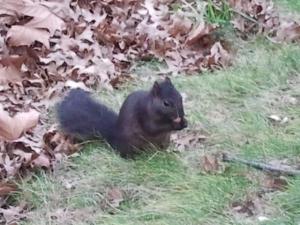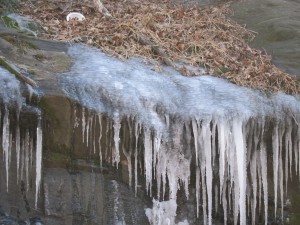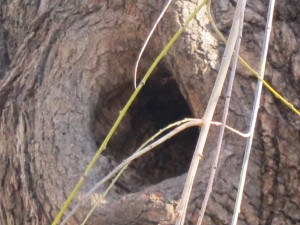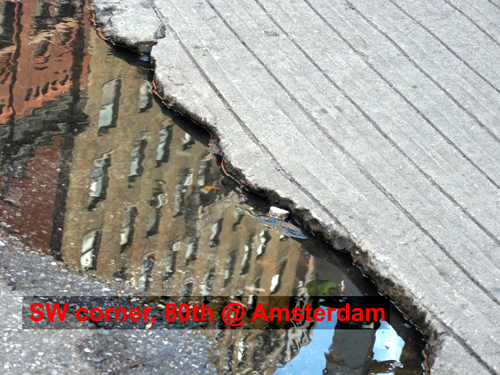A fellow nature lover recently told me of seeing a black squirrel repeatedly in the northern end of Central Park.

Black squirrel in Central Park.
The squirrel usually seen in NYC parks is the Eastern gray squirrel, Sciurus carolinensus. Eastern grays love hardwood forests that provide them with acorns, berries, bark, insects and tree buds. In the old days, before the virgin forests of the east were cleared, it was said that a squirrel could travel the entire east coast in the treetops, without ever touching ground.
And travel Gray squirrels did, and sometimes, perhaps, still do. Audubon and other early American naturalists called it the Migratory squirrel for its mass migrations through the trees, which Charles Joseph Latrobe described in 1811:
“A countless multitude of squirrels, obeying some great and universal impulse, which none can know but the Spirit that gave them being, left their reckless and gambolling life, and their ancient places of retreat in the north, and were seen pressing forward by tens of thousands in a deep and sober phalanx to the South …”
Other nineteenth century writers describe Gray squirrel migrations that lasted up to four weeks and involved hundreds of thousands of animals.
Today’s Gray squirrels live in whatever wilderness remains to us, while also thriving in the suburbs and in urban parks. Black squirrels, according to most researchers, are a melanistic color morph, or variation, of the Gray squirrel, the color resulting from an excess of melanin, a dark pigmentation. Essentially, black squirrels are simply black Grays.
I’d heard of black squirrel populations in other parts of NYC, including Union Square Park and the grounds of Stuyvesant Town and Peter Cooper Village. City parks can be like islands, separated by streets instead of water, where inbreeding leads to swift manifestation of unusual genetic traits, including melanism. Was a nascent population of black squirrels emerging in Central Park? I decided to go squirrel hunting.
The morning glowed with sunlight that failed to warm.

Central Park boulder sporting icicles.
Despite the bitter cold, someone appeared to be meditating on a point of land that jutted out into the still-unfrozen Pool, the little pond at 101st Street.

A peaceful moment.
A mixed flock of ducks paddled about, and a few came over to see if I was offering food. (I wasn’t.)

Who gets the girl?
The stretched-out neck of one of the male Mallards is a behavior called ‘steaming’ and is one of many Mallard courtship displays. The ducks are already pairing up in preparation for spring nesting.
Across the Pool, Buffleheads, a particularly adorable duck species, dove and surfaced, flashing their big white heads and sides.

Quick-diving ducks: Now you see them, now you don’t.
Buffleheads, like scaup, mergansers and canvasbacks, are diving ducks, capable of swimming underwater to feed, while Mallards, like American wigeons, teals and shovelers, are dabbling ducks, tipping up their tails to feed with their heads underwater. Mallard ducklings regularly dive underwater to avoid predators, although duckling predators also include water dwellers, like snapping turtles and fish.
But I digress. A good walk makes for many digressions. I resumed my hunt for the black squirrel, heading south through the park all the way down to 89th Street.
Along the way, I saw a huge flock of Common grackles. (Birder friends, these are grackles and not some kind of blackbird, yes?)

Just a small corner of a much larger flock.
The flock was accompanied – or, perhaps, infiltrated – by a solitary bluejay.

One thing is not like the others.
I saw perfect squirrel hideouts.

Anyone in there?
I saw squirrel dreys, or nests, including this one high in a tree.

Apartment with 360-degree view.
And, inevitably, I saw squirrels. Just a few, due to the cold, and all of them normal Grays, like this little fellow in the fork of a tree.

Gray squirrel keeps an eye on the passing world.
So I’m still looking for my first black squirrel.
When I returned home, I discovered that while I was traipsing the Park’s north end, a black squirrel had been hanging out down at the southern end, near Wollman Rink.

Black and Gray, just chillin’.
Meanwhile, I’ve learned from a favorite naturalist in England that across the Big Pond, in the U.K., black squirrels are a source of serious controversy. All Gray squirrels are considered an invasive species there, as they drive out the native red squirrel population. But there’s something about black Grays that … well, more on black squirrels in a future post. Meanwhile, do let me know if you see any unusual squirrels around your neck of the woods.
Photos by Melissa Cooper. Black squirrel photos by Gigi A.
Melissa Cooper is a West Side Rag columnist. She runs the blog Out Walking the Dog, where she published a version of this column.









I saw two black squirrels in City Hall Park on Friday, Jan. 27 around 10 a.m. They were on the Broadway side of the park, near the fence along the sidewalk.
RIGHT YOU ARE. THERE AT LEAST 2 BLACK ONE IN CITY HALL PARK.HAVE SEEN THEM FOR SEVERAL YEARS NOW.
I live in the north Bronx, next to the Albert Einstein College of Medicine, and there are a number of black squirrels that hang about the campus. There are also plenty of gray squirrels, including one really fat one that likes to eat out of the garbage cans.
I walk through Washington Square most days during the week and it’s a rare day that I don’t see a black squirrel. There are at least two living there, but I see them so often I wouldn’t be surprised if there are more. I most often see them on the western/northern sides of the square. Good luck squirrel spotting 🙂
Thank you all so much for sharing your squirrel sightings. Based on comments here & on my blog, they seem to be much more common in NYC than I realized. In fact, I’m starting to wonder if I’m the only remaining New Yorker who HASN’T seen a black squirrel. Surely my time will come… Again, thanks for the responses!
There are a bunch of black squirrels on the Fordham (Bronx) campus, along with grey ones, and a few that look like they are from mixed parentage.